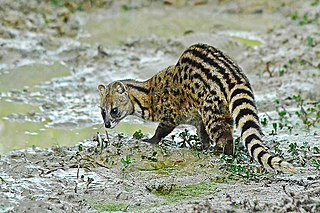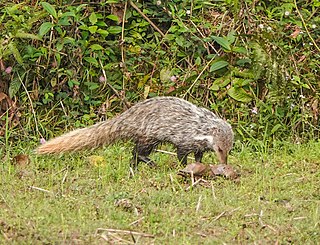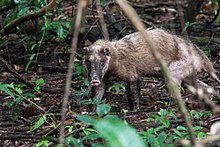
The small Indian civet is a civet native to South and Southeast Asia. It is listed as Least Concern on the IUCN Red List because of its widespread distribution, widespread habitat use and healthy populations living in agricultural and secondary landscapes of many range states.

The crab-eating mongoose is a mongoose species ranging from the northeastern Indian subcontinent and Southeast Asia to southern China and Taiwan. It is listed as Least Concern on the IUCN Red List.

The banded palm civet, also called the banded civet, is a viverrid native to Indomalaya. They primarily inhabit lowland conifer habitat, which is under threat from encroaching human activity. It is estimated the population of the banded palm civet has decreased by around 30% in just three generations. Banded palm civets are usually approximately the size of a domestic cat; their fur is pale but with dark bands on the back. They are believed to be closely related to Hose's palm civets, which are similar in appearance and distribution.

The masked palm civet, also called the gem-faced civet or Himalayan palm civet, is a viverrid species native to the Indian subcontinent and Southeast Asia. It has been listed as least concern on the IUCN Red List since 2008 as it occurs in many protected areas, is tolerant to some degree of habitat modification, and widely distributed with presumed large populations that are unlikely to be declining.

Alaungdaw Kathapa National Park is a national park in Myanmar covering 541.6 sq mi (1,403 km2). It was established in 1989 and is listed as one of the ASEAN Heritage Parks. It spans an elevation of 443–4,380 ft (135–1,335 m) in the Kani and Mingin Townships in Sagaing Region.
Hkakaborazi National Park is a national park in northern Myanmar with an area of 1,472 sq mi (3,810 km2). It was established in 1998. It surrounds Hkakabo Razi, the highest mountain in the country. It ranges in elevation from 2,950 to 18,730 ft comprising evergreen forest and mixed deciduous forests in Nogmung Township, Kachin State. It is managed by the Nature and Wildlife Conservation Division. It is contiguous with Bumhpa Bum Wildlife Sanctuary and Hukaung Valley Wildlife Sanctuary. These protected areas together with Hponkanrazi Wildlife Sanctuary comprise the largest continuous expanse of natural forest called the Northern Forest Complex stretching over an area of 11,624 sq mi (30,110 km2). Its objective is to conserve the biodiversity of the Ayeyarwady and Chindwin river basins.

Hukaung Valley Wildlife Sanctuary is a protected area in northern Myanmar, covering 17,373.57 km2 (6,707.97 sq mi). It was established in 2004 and extended to its present size in 2010. It was initially gazetted in 2004 with an area of 6,371 km2 (2,460 sq mi) in Tanaing Township and extended to Kamaing, Nayun and Kamti Townships. In elevation, it ranges from 125 to 3,435 m in the Hukawng Valley located in Kachin State and Sagaing Region. It harbours evergreen and mixed deciduous forests.
Rakhine Yoma Elephant Range is a protected area in Myanmar's Rakhine Yoma mountains, covering about 1,756 km2 (678 sq mi) of evergreen and mixed deciduous forest at an elevation of 20–1,270 m (66–4,167 ft).
Htamanthi Wildlife Sanctuary is a 2,150.73 km2 (830.40 sq mi) large protected area in northern Myanmar. It was established in 1974 in the Sagaing Region.

Tanintharyi Nature Reserve is a strict nature reserve in Myanmar's Tenasserim Hills, covering 1,699.99 km2 (656.37 sq mi). In elevation, it ranges from at an elevation of 20–130 m (66–427 ft). Most of the tropical rain forest is evergreen, interspersed with some grassland. The reserve provides habitat to Asian elephant and Gurney's pitta. It was gazetted in 2005 for the maintenance of natural resources, scientific research and education of local people in surrounding communities.
Bumhpa Bum Wildlife Sanctuary is a protected area in Myanmar, covering an area of 1,854.43 km2 (716.00 sq mi). It was established in 2004. It ranges in elevation from 140 to 3,435 m and harbours evergreen forest in Kachin State.
Mahamyaing Wildlife Sanctuary is a protected area in Myanmar's Sagaing Region, covering an area of 1,181 km2 (456 sq mi). It ranges in elevation from 145 to 590 m and was established in 2002 in Kalay and Mawlaik Townships.

Hponkanrazi Wildlife Sanctuary is a protected area in northern Myanmar, stretching over an area of 2,703.95 km2 (1,044.00 sq mi). It was established in 2003. It encompasses riverine habitats, subtropical moist forest, temperate forest, deciduous forest and alpine forest. It is contiguous with Hkakaborazi National Park, Bumhpa Bum Wildlife Sanctuary and Hukaung Valley Wildlife Sanctuary. Together, they form a 30,269 km2 (11,687 sq mi) large protected area complex of natural forest called the Northern Forest Complex. It is managed by the Forest Department.
Panlaung and Padalin Cave Wildlife Sanctuary is a protected area in Myanmar's Shan State near Ywangan Township, stretching over an area of 333.8 km2 (128.9 sq mi). It was established in 2002 under the Wildlife Protection Act of 1936. In elevation, it ranges from 150 to 1,555 m covering mixed deciduous and dipterocarp forest.

Hog badgers are three species of mustelid in the genus Arctonyx. They represent one of the two genera in the subfamily Melinae, alongside the true badgers.

The northern hog badger is a species of mustelid native to South and East Asia.
The Sumatran hog badger is a species of mustelid endemic to the island of Sumatra in Indonesia.












